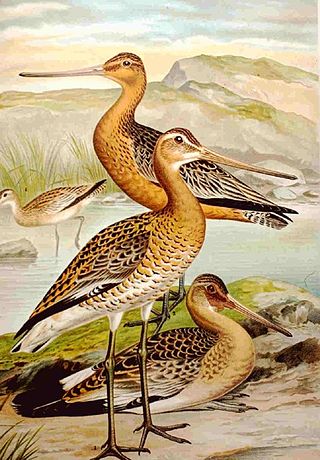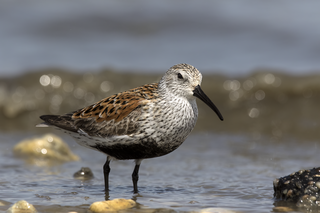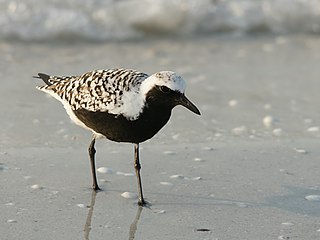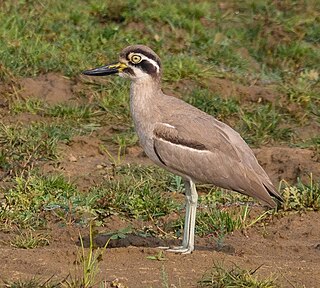
Scolopacidae is a large family of shorebirds, or waders, which mainly includes many species known as sandpipers, but also others such as curlews and snipes. The majority of these species eat small invertebrates picked out of the mud or soil. Different lengths of bills enable different species to feed in the same habitat, particularly on the coast, without direct competition for food.

The curlews are a group of nine species of birds in the genus Numenius, characterised by their long, slender, downcurved bills and mottled brown plumage. The English name is imitative of the Eurasian curlew's call, but may have been influenced by the Old French corliu, "messenger", from courir , "to run". It was first recorded in 1377 in Langland's Piers Plowman "Fissch to lyue in þe flode..Þe corlue by kynde of þe eyre". In Europe "curlew" usually refers to one species, the Eurasian curlew.

The godwits are a group of four large, long-billed, long-legged and strongly migratory waders of the bird genus Limosa. Their long bills allow them to probe deeply in the sand for aquatic worms and molluscs. In their winter range, they flock together where food is plentiful. They frequent tidal shorelines, breeding in northern climates in summer and migrating south in winter. A female bar-tailed godwit made a flight of 29,000 km (18,000 mi), flying 11,680 kilometres (7,260 mi) of it without stopping. In 2020 a male bar-tailed godwit flew about 12,200 kilometres (7,600 mi) non-stop in its migration from Alaska to New Zealand, previously a record for avian non-stop flight. In October 2022, a 5 month old, male bar-tailed godwit was tracked from Alaska to Tasmania, a trip that took 11 days, and recorded a non-stop flight of 8,400 miles (13,500 km).

The dunlin is a small wader, formerly sometimes separated with the other "stints" in the genus Erolia. The English name is a dialect form of "dunling", first recorded in 1531–1532. It derives from dun, "dull brown", with the suffix -ling, meaning a person or thing with the given quality.

The Eurasian curlew or common curlew is a very large wader in the family Scolopacidae. It is one of the most widespread of the curlews, breeding across temperate Europe and Asia. In Europe, this species is often referred to just as the "curlew", and in Scotland known as the "whaup" in Scots.

The Eurasian or common whimbrel, also known as the white-rumped whimbrel in North America, is a wader in the large family Scolopacidae. It is one of the most widespread of the curlews, breeding across much of subarctic Asia and Europe as far south as Scotland. This species and the Hudsonian whimbrel have recently been split, although some taxonomic authorities still consider them to be conspecific.

The grey plover or black-bellied plover is a large plover breeding in Arctic regions. It is a long-distance migrant, with a nearly worldwide coastal distribution when not breeding.

The long-billed curlew is a large North American shorebird of the family Scolopacidae. This species was also called "sicklebird" and the "candlestick bird". The species breeds in central and western North America, migrating southward and coastward for the winter.

The Eskimo curlew, also known as northern curlew, is a species of curlew in the family Scolopacidae. It was one of the most numerous shorebirds in the tundra of western Arctic Canada and Alaska. Thousands of birds were then killed per year in the late 1800s. As there has not been a reliable sighting since 1987 or a confirmed sighting since 1963, the Eskimo curlew is considered Critically Endangered or possibly extinct. The bird was about 30 cm (12 in) long and fed mostly on insects and berries.

The pied avocet is a large black and white wader in the avocet and stilt family, Recurvirostridae. They breed in temperate Europe and across the Palearctic to Central Asia then on to the Russian Far East. It is a migratory species and most winter in Africa or southern Asia. Some remain to winter in the mildest parts of their range, for example in southern Spain and southern England. The pied avocet is one of the species to which the Agreement on the Conservation of African-Eurasian Migratory Waterbirds (AEWA) applies.

The curlew sandpiper is a small wader that breeds on the tundra of Arctic Siberia.

The slender-billed curlew is a bird in the wader family Scolopacidae. Isotope analysis suggests the majority of the former population bred in the Kazakh Steppe despite a record from the Siberian swamps, and was migratory, formerly wintering in shallow freshwater habitats around the Mediterranean. This species has occurred as a vagrant in western Europe, the Canary Islands, the Azores, Oman, Canada, and Japan. The slender-billed curlew was always a rare species and is feared extinct, with the last verifiable sighting being in 2004.

The little curlew is a wader in the large bird family Scolopacidae. It is a very small curlew, which breeds in the far north of Siberia. It is closely related to the North American Eskimo curlew.

The great stone-curlew or great thick-knee is a large wader which is a resident breeder in tropical southern Asia from India, Pakistan, Sri Lanka, Bangladesh into South-east Asia.

The bristle-thighed curlew is a medium-sized shorebird that breeds in Alaska and winters on tropical Pacific islands.

Roebuck Bay is a bay on the coast of the Kimberley region of Western Australia. Its entrance is bounded in the north by the town of Broome, and in the south by Bush Point and Sandy Point. It is named after HMS Roebuck, the ship captained by William Dampier when he explored the coast of north-western Australia in 1699. The Broome Bird Observatory lies on the northern coast of the bay.

The milky stork is a stork species found predominantly in coastal mangroves around parts of Southeast Asia. It is native to parts of Cambodia, Vietnam, Malaysia and Indonesia. They were once part of the genus Ibis, but is currently included in the genus Mycteria, due to similarities with other storks in that genus.

The Far Eastern curlew is a large shorebird most similar in appearance to the long-billed curlew, but slightly larger. It is mostly brown in color, differentiated from other curlews by its plain, unpatterned brown underwing. It is not only the largest curlew but probably the world's largest sandpiper, at 60–66 cm (24–26 in) in length and 110 cm (43 in) across the wings. The body is reportedly 565–1,150 g (1.246–2.535 lb), which may be equaled by the Eurasian curlew. The extremely long bill, at 12.8–20.1 cm (5.0–7.9 in) in length, rivals the bill size of the closely related long-billed curlew as the longest bill for a sandpiper.

The red-headed myzomela or red-headed honeyeater is a passerine bird of the honeyeater family Meliphagidae found in Australia, Indonesia, and Papua New Guinea. It was described by John Gould in 1840. Two subspecies are recognised, with the nominate race M. e. erythrocephala distributed around the tropical coastline of Australia, and M. e. infuscata in New Guinea. Though widely distributed, the species is not abundant within this range. While the IUCN lists the Australian population of M. e. infuscata as being near threatened, as a whole the widespread range means that its conservation is of least concern.

Burhinus is a genus of birds in the family Burhinidae. This family also contains the genus Esacus. The genus name Burhinus comes from the Greek bous, ox, and rhis, nose.






















